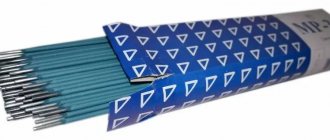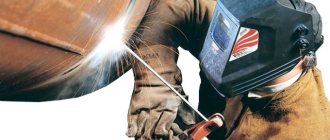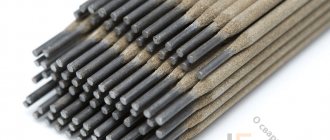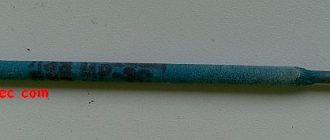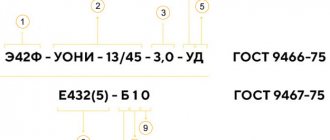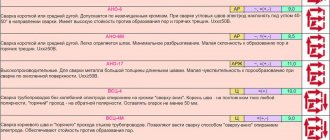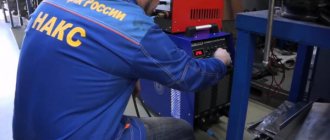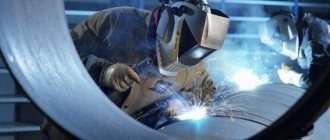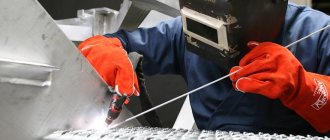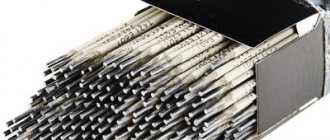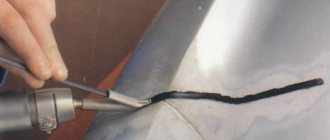| Place | Name | Characteristics in the rating |
| The best welding electrodes with basic coating |
| 1 | ESAB UONI 13/55 (350 x 3.0 mm; 4.5 kg) | Best price for basic electrodes |
| 2 | KOBELCO LB-52U (350 x 3.2 mm; 5 kg) | The best combination of price and quality |
| 3 | QUATTRO ELEMENTI 771-374 (350 x 2.5 mm; 0.9 kg) | The best combination of mechanical characteristics of the electrode metal |
| 4 | ESAB FILARC 88S (350 x 2.5 mm; 7.2 kg) | High quality of the resulting welded joints. Special Series |
| 5 | “KEDR” E 308L-16/OZL-8 (350 x 3.2 mm; 2 kg) | The best basic coated electrodes for welding high alloy steels |
| The best rutile coated welding electrodes |
| 1 | ESAB OK 46.30 (450 x 5.0 mm; 18.9 kg) | The most economical electrodes |
| 2 | Quattro Elementi 772-166 (300 x 2.0 mm; 3 kg) | High degree of popularity |
| 3 | "Resanta" MR-3S (350 x 3 mm; 3 kg) | The most favorable price offer |
| 4 | Inforce MP-3 11-05-01 (450 x 5 mm; 5 kg) | Balanced mechanical performance |
| 5 | ELITECH MP-3C (350 x 3 mm; 5 kg) | Optimal combination of price and quality of the deposited layer |
| Best Cellulose Coated Welding Electrodes |
| 1 | ESAB Pipeweld 7010 Plus (350 x 4.0 mm; 20 kg) | Good resistance of electrodes to overheating |
| 2 | "SpetsElectrode" MP-3S (450 x 4 mm; 5 kg) | High welding conditions without preliminary metal preparation |
| 3 | "Monolith" RC ANO-36 (4 mm; 5 kg) | Best price |
| Best Acid Coated Welding Electrodes |
| 1 | ESAB OK 67.71 (350 x 3.2 mm; 4.8 kg) | Wide range of applicability. High quality welds |
| 2 | ESAB OK 61.20 (30 x 2.5 mm; 4.2 kg) | Optimal cost parameters |
Welding electrodes are a mandatory consumable material used during welding operations. Its essence lies in introducing additional (electrode) metal into the weld pool formed when the base metal melts in the weld zone. The result of this action will be a permanent connection capable of absorbing various types of loads and ensuring rigidity or tightness (in the case of pipe welding) of the structure.
Simple in words, in reality this process requires a fair amount of preparation, including in terms of selecting electrodes. It is not enough to select a consumable element with a metal whose properties are as close as possible to the main one. The market is gradually filled with competing products, so even professionals, let alone novice users, often fail to make the right choice in such an environment. After studying reviews from consumers and experts, we have prepared for you a rating of the best welding electrodes, divided into four main categories.
The best welding electrodes with basic coating
Electrodes with a basic coating are used quite often, since they do not impose strict restrictions on welding. The parts to be welded can be oriented in space at any angle - the electrode works in all spatial positions. In addition, not only thin metal products can be subjected to the process of obtaining a permanent connection - thick sheets of metal and thick-walled structures are also subject to welding with the main electrode. The only condition: these processes must take place at a constant current of reverse polarity.
Popular manufacturers
Electrodes of varying quality are produced all over the world: from Russia and China to America and Germany. Foreign rods, as a rule, are more expensive than domestic ones, but many welders believe that our products are not as bad as they say.
By purchasing, say, American electrodes, you can be sure of their quality and good performance, but you have to pay twice as much for this. And at the same time, by purchasing Russian electrodes you get a lower price, but at the same time less strict quality control in production. Which country's electrodes are better than others is a long-standing topic of debate.
We will not argue that domestic electrodes are definitely worse; we will give you this choice. We will only tell you about the best electrodes that we were able to try. So, what electrodes do we recommend for purchase? Judging by the reviews and our experience, the best welding electrodes are produced by the brands ESAB, Kobelco, Resanta, UONI and Lincoln Electric. Some manufacturers specialize in the manufacture of electrodes of one type, while others produce rods with both basic and rutile coatings.
The best rutile coated welding electrodes
Rutile electrodes have gained great popularity among welders due to a combination of useful characteristics. They have easy ignition, are highly resistant to moisture, and can also be used on direct and alternating current. Their disadvantages include the impossibility of welding structures made of high-carbon steel, the direct dependence of the quality of the seam on the welding modes, as well as the need for careful preparatory operations (such as drying and calcination of the surface).
Electrodes for welding with an inverter: which brands are best to choose in 2021-2022?
I would like to immediately make a reservation - there is an opinion circulating in Russia that only foreign suppliers of consumables can be considered quality. Such thoughts are justified by the assembly of the welding machines themselves. While this is indirectly related to the equipment, it is clearly a misconception regarding the electrodes. Rods for welding are made in accordance with GOST standards, therefore the quality is in no way inferior to foreign analogues.
1) The best electrodes for inverter welding for beginners
The question that beginners ask about the best electrodes for inverter welding arises most often, so that’s where we’ll start our analysis of the top three ratings. Preference should be given to rods that are coated with rutile. The rationale is simple – such electrodes are easier to use in practice. Below I will present the top 2 brands of such rods for the current period of time.
A) ANO-4
| Price | ★★★★★ (5.0 out of 5.0) | Overall attractiveness ★★★★★ 5.0 |
| Ease of use: | ★★★★★ (5.0 out of 5.0) | |
| Reviews | ★★★★★ (5.0 out of 5.0) |
Electrodes type E46 with rutile coating. The basic purpose is inverter welding of carbon and low-alloy types of steel. Can be used with both direct and alternating current, regardless of the chosen polarity. There is one contraindication to use in spatial position - from top to bottom vertically.
Electrode specifications:
- rutile spraying;
- deposition coefficient 8.6 g per A*h;
- the productive part for surfacing is about 1.4 kg/h for a rod diameter of 4 mm;
- resistance 480 MPa;
- yield limit 380 MPa;
- relative elongation 25%.
They are produced in diameters from 2 to 6 mm, but 4 mm rods are most common. Packaging is carried out in packs of 1, 2.5 and 5 kilograms. The number of pieces is determined by the diameter of the rod - from 11 to 39 pieces. According to reviews from welders, this product is the optimal solution for a novice welding specialist.
B) UTP 65D
| Price | ★★★★ (4.0 out of 5.0) | Overall attractiveness ★★★★★ 4.5 |
| Ease of use: | ★★★★★ (5.0 out of 5.0) | |
| Reviews | ★★★★★ (5.0 out of 5.0) |
A more expensive foreign analogue comes from Austria. The electrodes perform well when welding with dissimilar steels and alloys. They are not tied to the type of welding current and polarity. The coating of the rods is exclusively rutile.
What a welder will get when working with UTP 65D:
- arc stability;
- no splashing;
- the ability to weld thin-walled and thick-walled metals without problems;
- seams without pores, which can be processed immediately after cooling;
- cold hardening of metal along the seam;
- simple slag separation;
- The rod's tolerance to dampness, overheating and creeps with undercuts.
Before use, the electrodes are dried for 120 minutes at a temperature of 160 degrees. The welding area is thoroughly cleaned, and when working with thick-walled elements, a V-shaped edge with a bevel angle of 60-70 degrees should be prepared. The rods are often used by auto repair shops to carry out repair work on car bodies.
2) Electrodes for household welding
There are 2 features of the household welding work - medium (low) level of complexity + no special requirements for the quality of the seam. When a person decides which household electrodes for welding with an inverter is best for a beginner to choose, his main criterion is the ease of use of the rod, and the next two candidates satisfy the stipulated condition 100%.
A) UONI-13/55
| Price | ★★★★ (4.0 out of 5.0) | Overall attractiveness ★★★★★ 4.5 |
| Ease of use: | ★★★★ (4.0 out of 5.0) | |
| Reviews | ★★★★★ (5.0 out of 5.0) |
The roots of these rods go back to Soviet times. The type of electrodes is E50A, and in terms of coating, “basic” is preferred. The spray composition of carbonates and fluoride compounds reduces the gas content of the resulting seam. The number of non-metallic inclusions is reduced, among other things.
Technical characteristics of UONI-13/55:
- the deposition coefficient is 9.5 g per A*h;
- in an hour of surfacing with an electrode 4 mm in diameter, you can get up to 1.4 kg of metal;
- consumption per 1 kg of deposited metal is about 1.7 kg of rods;
- yield limit 420 mPa;
- tensile strength 530 MPa;
- the relative elongation rate is 22%;
- impact strength varies depending on temperature from 50 to 130 J/sq. cm.
The rod output diameter ranges from 2 to 4 mm, the accompanying number of pieces per package respectively from 15 to 98, depending on the thickness. Electrodes should be used on direct current with reverse polarity (+). Any spatial position is allowed except vertical from top to bottom.
B) MR-3
| Price | ★★★★ (4.0 out of 5.0) | Overall attractiveness ★★★★★ 4.5 |
| Ease of use: | ★★★★★ (5.0 out of 5.0) | |
| Reviews | ★★★★★ (5.0 out of 5.0) |
Electrodes of type E46, having 2 types of coating - BR and R. They are used advantageously for welding critical structures made of carbon and low-alloy steels. Welding of elements of medium and large thickness is acceptable.
Special properties of MP-3 electrodes:
- high arc stability;
- moderate amount of splashes;
- quick and easy separation of slag crust;
- just re-ignite.
Before use, it is necessary to thoroughly clean the welding surface from scale. Rods are produced in diameters from 3 to 5 mm, and packaged in packages from 1 to 5 kg. There are 3 types of colors depending on the type of coating - blue, red, and green. Welding with rods is permissible in all spatial positions other than vertical from top to bottom.
3) Rods for stainless steel
At home, when working with an inverter, there is often a need to carry out welding work on stainless steel. The use of universal electrodes is acceptable here, but the seams will gradually oxidize and become rusty. To increase durability, it is recommended to use specialized rods.
A) NZh-13
| Price | ★★★★ (4.0 out of 5.0) | Overall attractiveness ★★★★★ 4.5 |
| Ease of use: | ★★★★ (4.0 out of 5.0) | |
| Reviews | ★★★★★ (5.0 out of 5.0) |
These electrodes are the best for inverter welding for beginners who work with stainless steel on a periodic or permanent basis. There are 2 types of rods - 04Х19Н11М3 and E-09Х19Н10Г2М2Б. All have “basic” coverage. Purpose – welding of corrosion-resistant steels with a high safety margin.
Features of inverter welding of stainless steel
Characteristics of electrodes:
- surfacing coefficient 13 g per A*h;
- in terms of surfacing productivity we get 1.7 kg per 1 hour of work with a diameter of 4 mm;
- To obtain 1 kg of surfacing, 1.8 electrodes are consumed.
The deposited metal contains up to 10% ferrite phase. The production diameters in the Russian Federation are from 3 to 5 mm, and the average packing in packs is from 18 to 45 pieces as the thickness of the rod increases. The work must be carried out at direct current with reverse polarity. Use in a vertical position from top to bottom is not acceptable.
Analysis of the most popular electrodes for home welding with an inverter:
B) TsL-11
| Price | ★★★★★ (5.0 out of 5.0) | Overall attractiveness ★★★★★ 4.5 |
| Ease of use: | ★★★★ (4.0 out of 5.0) | |
| Reviews | ★★★★ (4.0 out of 5.0) |
Inexpensive electrodes type E-08Х20Н9Г2Б. The coating used is “basic”. They perform well for working with stainless steel, even when the latter is in unsatisfactory condition. Suitable for use in all spatial positions with the exception of vertical.
Characteristics of rods:
- the rods use specialized welding wire that complies with GOST 246-70;
- surfacing productivity in 60 minutes is up to 1.5 kilograms;
- deposition factor - 11 grams per Ampere per hour;
- to obtain 1 kg of deposited metal it is necessary to use 1.7 kg of rods.
Before use, the electrodes should be calcined for 60 minutes at a temperature of 190 degrees Celsius. Welding current for comfortable work is constant with reverse polarity (+). The distribution of the brand is quite wide, so choosing a manufacturer to your liking will not be a problem.
Rods for welding cast iron products can also be classified into a separate category. I consider MNCh-2, OZZHN-1, OZCh-2, TsCh-4 and OK 92.18 optimal for home use. Due to the increased popularity of cast iron in the household sector, the specified brands will certainly be useful to you. This concludes the analysis of the question of which electrodes to choose for welding with an inverter for a beginner. If you have in mind alternative brands of easy-to-use electrodes, then please feel free to comment. Good luck and easy welding!
AURORA
The Chinese company Aurora, focused on the European and Russian markets, produces inverters using MOSFET and IGBT technology. The company's catalog includes 26 devices of the ARC, Maxima, Minion, PRO Inter, Stickmate series. All products are certified according to ES, GB standards and EAEU legislation (TR TS 010/2011 “On the safety of machinery and equipment”, TR TS 004/2011 “On the safety of low-voltage equipment”, TR TS 020/2011 “Electromagnetic compatibility of technical equipment”). The devices come with a 2-year warranty, and post-warranty support is also provided. The price of inverters, depending on power and configuration, varies from 4,000 to 112,000 rubles.
One of the most popular models is AURORA INTER 160 (10030). This welding machine can be used both for household and professional use. Operates from a 220 V network. Power is 4.6 kW, welding current is up to 160 A. The thickness of the working electrode is 1.6–4 mm. Model dimensions 290x130x200 mm, weight 5.5 kg. Distinctive characteristics include reduced spatter, easy ignition and hot start. The delivery set includes cables with a grounding clamp and an electrode holder. Price: 10,400 rubles.
Kobelco LB-52U
Another type of welding electrode, which is manufactured in Japan. It is worth noting that these products are used in cases where it is not possible to work on both sides of the surface, for example, when welding a pipeline.
The substance is very expensive, but the quality speaks for itself. The reliability of these electrodes is justified by the high price, as well as numerous works by experienced specialists.
For maximum reliability, it is recommended to work under direct current, however, using alternating current is also suitable, but the quality will then be slightly lower.
We recommend this type if you want to get a perfectly even seam when used with low-carbon types of steel, as well as for the ability to work in any direction. In some cases, when the material lies in a damp place, calcination up to 300 degrees may be required.
Recommendations when choosing
There is no significant difference in the choice of electrodes for inverter and transformer type welding
First of all, to choose the best electrode for welding, you should pay attention to the deposition rate, packaging (be sure to make sure it is original), storage, consumption, and also check the quality certificate and manufacturer’s license
The deposition coefficient is determined by the ratio of the content of useful (pure) metal in the rod. Popular brands cannot always boast of high performance. If the transportation, period and place of storage of the rods are violated, the quality of the material deteriorates.
What should the current be?
The required welding current directly depends on the thickness of the metal with which you will have to work. The maximum electrode diameter is selected for a specific metal thickness.
If you work with a metal thickness of 1–2 mm, the maximum current will be 65–85 A. When welding metal with a thickness of 2–5 mm, you will need a current of 100–120 A. If the metal is 5–10 mm thick, you need to count on the maximum current 210–240 A.
It is important not to forget that the amperage specified by the manufacturer must be higher than necessary, since the indicated values often do not coincide with reality. For stable operation, it is better not to use the device at its power limit.
